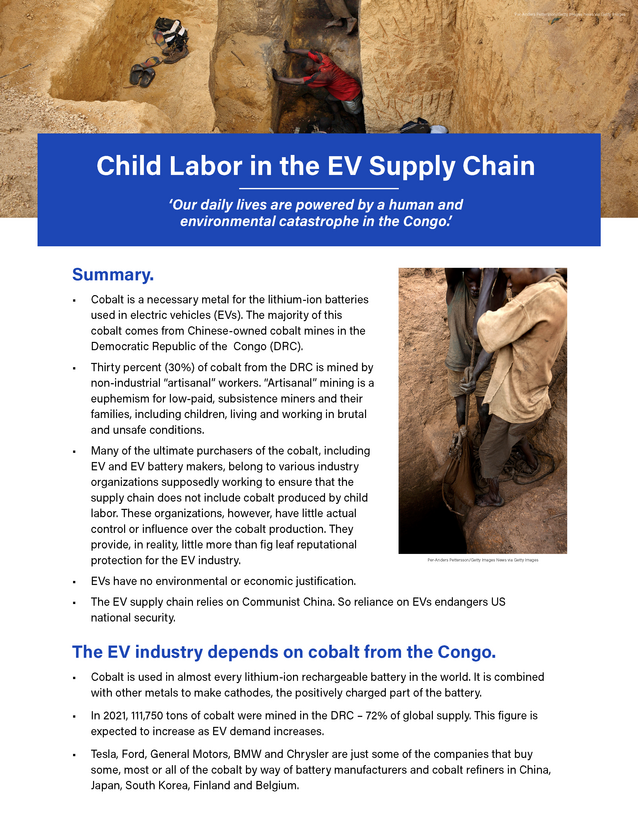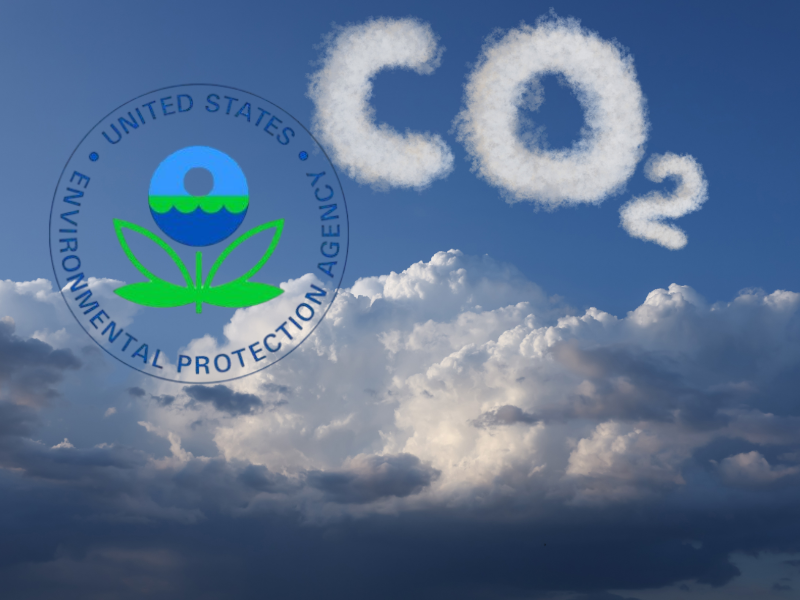YOU SHOULD SUBSCRIBE TO CLIMATE CHANGE WEEKLY.
IN THIS ISSUE:
- Associated Press Takes More Money to Promote Climate Alarm
- Podcast of the Week: Biden Wants to Ban Your Favorite Appliances (Guest: Ben Lieberman)
- Asheville, North Carolina Has an EV Bus Problem
- Dispatchable Power, Mainly Fossil Fuels, Serves as Texas Grid Backbone During Freeze
- Climate Comedy
- Video of the Week: Climate Trial of the Century: Mann vs Steyn
- Recommended Sites
Miss Anything at Heartland’s Climate Conference? No Problem.

Associated Press Takes More Money to Promote Climate Alarm
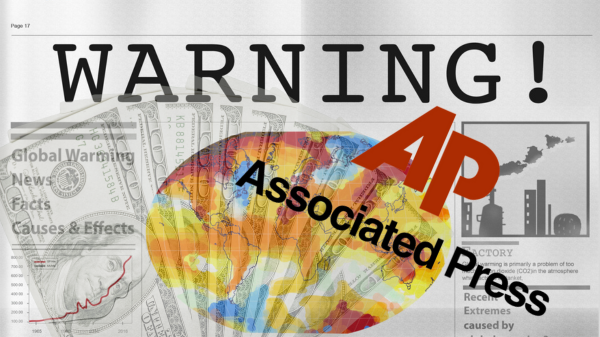
The Associated Press (AP) recently accepted a grant of approximately $300,000 from the KR Foundation, a Danish organization founded to “address the climate crisis by pushing for a rapid phase-out of fossil fuels at a global level.”
This follows a $8 million grant to the AP by five U.S.-based foundations—the William and Flora Hewlett Foundation, the Howard Hughes Medical Institute, Quadrivium, the Rockefeller Foundation, and the Walton Family Foundation—in February 2022. Those foundation devote significant funds to motivating carbon restricting policies at the federal, state, and local levels of government. That grant directed the AP to hire more than two dozen journalists to report on climate issues, primarily from Africa, Brazil, India, and the United States.
Now, the Danish group is giving the AP additional money to continue and expand its efforts to stoke climate alarm through its “global scholars network.”
The New American is skeptical of the AP’s claim “that it maintains strict editorial independence,” for its climate content, despite the significant infusion of funds dedicated specifically to expanding the agency’s climate reporting.
“A quick check of its recent headlines on the subject of climate change might give a skeptic pause to wonder at the truth of that claim,” writes The New American. “For instance, recent headlines include ‘Climate change threatens Bolivian “cholitas” livelihood’ on November 30; ‘Climate change hits women’s health harder. Activists want leaders to address it at COP28,’ on November 20; and ‘Endangered species list grows by 2,000. Climate change is part of the problem,’ on December 11.”
It could, of course, be purely a coincidence that the AP increased its slanted, alarmingly headlined and written climate coverage in the countries specified by the grants, but one suspects it isn’t since, at the time of the initial grant in 2022, Julie Pace, a senior AP vice president, said “This far-reaching initiative will transform how we cover the climate story.”
“AP stories with anything positive to say about climate skepticism are scarce, if any exist at all, which makes one wonder if the New York Post editorial board was right in February of last year when it opined on the AP’s climate coverage: ‘Sorry: This is news-as-prostitution. Pay the media to get the coverage you want,’” continued The New American.
At the time the AP accepted its initial climate reporting grant, I noted that I thought it was just making public and official what I had long maintained was the AP’s operational practice: passing off press releases and blog posts from climate change activists and groups and those who fund them as if they were actual news stories.
The reporting I’ve seen from the AP since then only confirms this view. Since the AP received its first grant directing it to cover global climate change more extensively, as detailed at Climate Realism, the AP has published dozens of stories that were patently false—long on assertions and opinions, but short on facts—from misleading claims about climate change causing a decline in endangered birds, to provably false claims that climate change is creating refugees, to sparking fears of climate change-caused extended allergy seasons while ignoring the larger benefits of longer growing seasons.
The KR Foundation’s work has been especially focused on pressuring banks and investors to cease funding fossil-fuel projects, preventing fossil fuel companies or those who believe fossil fuels provide benefits from presenting their views, and supporting politicians and efforts to move to what it calls “the transition to a sustainable economic paradigm,” which, of necessity, requires the “rapid phase-out of fossil fuels at a global level.”
Be on the lookout for AP stories in the coming months focusing on these topics. I, for one, will be surprised if we don’t see an uptick of stories on these topics.
The AP’s coverage since its first climate grants—eschewing climate realists’ viewpoints, using “expert statements” or anecdotal claims in lieu of hard data when it comes to climate reporting, and its acceptance of the KR Foundation’s money—only cements my view that, on the topic of climate change, the AP has very publicly ceased to be a legitimate news gathering and reporting organization. It has become instead a bought and paid-for shill for the extreme environmental movement, spreading climate alarm around the world.
Upton Sinclair reportedly once said, “It is difficult to get a man to understand something when his salary depends upon his not understanding it.” Similarly, William Jennings Bryant reportedly said, “It is useless to argue with a man whose opinion is based upon a personal or pecuniary interest.”
Sources: Climate Change Weekly; The New American
Get your Copy at Amazon TODAY!
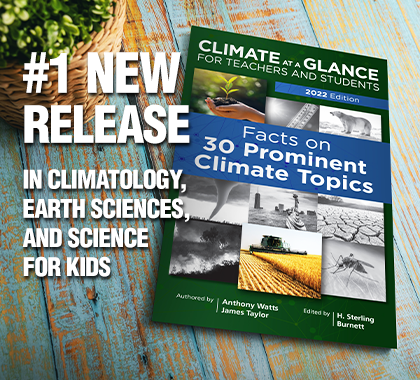
Podcast of the Week
In its obsessive pursuit of carbon dioxide emission reductions without regard to costs or freedom of choice, the Biden administration has conducted a regulatory assault on appliances, limiting consumers choice of appliances in a doomed attempt to control future weather. CEI Senior Fellow Ben Lieberman discusses how the energy efficiency mandates that the Biden administration is applying to a larger than ever range of appliances and products are limiting consumers freedom of choice, increasing costs, and forcing the sale of products that don’t have features that consumers want and that don’t work as well and the products they are replacing.
Subscribe to the Environment & Climate News podcast on Apple Podcasts, iHeart, Spotify or wherever you get your podcasts. And be sure to leave a positive review!
Read the brutal truth about how battery production for electric vehicles cause immense environmental destruction and human tragedy.
Asheville, North Carolina Has an EV Bus Problem

Asheville, North Carolina bought five electric buses in 2018 at a cost of more than $616,796. The Gateway Pundit reports that three of those five buses are now sitting idle, with one being offline for months for a broken door they are unable to get repaired.
“We haven’t been able to get new doors,” Asheville’s interim transportation director Jessica Morriss told abc13 News. “There’s no third party that makes a door. We’d have to get custom-made doors.”
It is doubtful it would take more than a week or two to get a door replaced on a normal diesel bus, getting the bus back on its route. But it is not just faulty or no service that is now causing Asheville’s transportation director to bemoan the decision to purchase electric buses. The initial cost of the buses is dwarfed by the maintenance, service, and ancillary costs unique to electric buses, as Gateway Pundit notes:
Morriss reveals a staggering total cost per bus nearing $1 million, including infrastructure for chargers and annual costs like leasing batteries and electric charges. And then there’s maintenance—another $251,000 spent on items like replacing traction drive controls for all buses. Maintenance director John McDaniel adds to the tale of woe, noting the replacement of power inverters at $14,000 each.
“The last couple of years have been particularly difficult,” Morriss laments, noting the bus manufacturer, Proterra, has filed for bankruptcy, making parts for repairs as elusive as a quiet day in their department. “We don’t see an end in sight,” she adds.
Worse still, even the fully operational buses often don’t make it through a full shift, especially in the winter when the transportation department often has to pull them offline for hours to charge, after as few as three round trips to the airport. In addition, in the cold the buses drain part of their charge just to warm up for operations.
Few may be surprised that Norway’s and Sweden’s green virtue-signaling electric bus experiments are proving to be busts, after all the winters in those Nordic countries are typically long and extreme. But Asheville has a relatively moderate climate. If electric buses don’t provide reliable, cost-effective service in temperate regions, the question rises, do they make sense anywhere.
This is especially true when one realizes that the very reason for their existence is to reduce public transportation-related greenhouse gas emissions. But, as Gateway pundit and other articles on similar situations elsewhere have remarked:
The ripple effects are felt across the city’s entire fleet, as biodiesel and hybrid buses pick up the slack, being run more frequently due to the electric buses’ frequent downtimes.
“There’s some lessons here for sure,” Morriss concedes, revealing a pause in further electric investments until they can ensure reliability.
Replacing reliable diesel or natural gas-powered buses with electric buses is foolish. Having idle rolling stock sitting around to fill-in for electric buses when they are not functioning is expensive, and using them as replacements for EVs in those situations defeats the purpose of buying EVs in the first place. No emissions are saved, but high, unnecessary costs are incurred.
Source: The Gateway Pundit
Heartland’s Must-read Climate Sites



Dispatchable Power, Mainly Fossil Fuels, Serves as Texas Grid Backbone During Freeze

Texas has a lot of different eco-regions with different temperature and precipitation profiles, but as a whole Texas is one of the warmest states in the nation, including during the winter. January is the coldest month in Texas and the average temperature then is still a relatively balmy 55 degrees. Historically, Texas has had a very reliable electric grid with little strain placed on the system during the winter, at least until federal, state, and local governments encouraged replacement of fossil fuel power plants with renewables dependent on the weather. For the purpose of this remainder of this summary, I’ll refer to wind and solar as “unreliables.”
This past week, Texas experienced an extended (week-long) spell of what is, for the Lone Star state, unusually cold temperatures. Temperatures across most of the state were well below freezing for most of the week. Both daytime highs and nighttime lows were 15 to 20 degrees or more below average. This cold weather challenged the state’s electric power system, despite the fact that in Texas, July and August, not January, are typically the months of peak demand.
In a post on the Master Resource blog, Doug Sheridan points out that, contrary to the sale pitch put out by the unreliable power industry, fossil fuels rescued Texas’ electric grid from collapse during that week, while the vast majority of renewables were absent without leave. Most of his analysis is posted below:
Having exhausted all efforts to find good-faith analyses by competent power-industry professionals or media experts focused on the condition of the Texas grid at critical points during severe cold spells, we’ve resorted to doing the analyses ourselves. Here’s our latest…
Given its current configuration, the “critical period” (highest risk of blackouts) in winter months on ERCOT is in the morning hours, just after most Texans start stirring and before the sun rises. On Monday and Tuesday of this week—with the effects of Winter Storm Heather—the critical period was at 7:50 AM each day.
With conservation notices covering the critical period on both days in place, system-wide demand during the critical period on Monday and Tuesday registered approximately 72.8 GW and 77.0 GW, respectively. At [t]his time, demand was being met with 48.2 GW and 49.3 GW of gas-fired generation, representing approximately 66.2% and 64.0% of supply, respectively. This was augmented by 12.8 GW (17.6%) and 12.3 GW (16.0%) of coal-fired generation and 5.1 GW (7.0%) and 5.1 GW (6.6%) of nuclear generation, respectively.
All summed, thermal generation accounted for 66.1 GW (90.8%) and 66.7 GW (86.6%) of systemwide demand during these periods on Monday and Tuesday. Yet, if one were to read the analyses of many industry analysts/consultants and the media outlets that parrot them, it’s wind and battery assets… like manna from heaven…. that kept the lights on when things got tight. Nothing could be farther from the truth.
To wit, solar contributed nothing at the critical period, as the sun had yet to rise across most of the state. And as they are prone to do during winter storms, wind assets contributed a paltry 5.1 GW (7.0%) and 9.0 GW (11.7%). Meanwhile, battery reserve, the new favorite of greens and in-the-tank energy reporters, contributed about 1 GW (1%) on both days. That’s a grand total of 6.1 GW (8.4%) and 9.9 GW (12.9%), respectively.
Of course, this winter is not the first to challenge Texas’ electric power system in recent years, and Sheridan’s is not the only analysis of the states’ electric power supply.
Nearly 250 people died in Texas when much of the state’s electric grid failed during a severe, but not unprecedented, freeze in February 2021. As I wrote at the time:
Data from the Electric Reliability Council of Texas shows four days before the first snowflake fell, wind and solar were providing 58 percent of the electric power used in Texas. Fortuitously, the sun had been shining and the wind blowing. These conditions ended, and within a matter of hours more than 13,000 megawatts of wind and solar power went offline. The wind died off and the turbines began to freeze, and winter storm clouds blocked the sun.
As always, natural gas, coal, and nuclear facilities ramped up production when wind and solar failed. Then the storm hit. Even as the wind picked up, ice had formed on the turbines, keeping them offline, and snow and ice coated solar panels, preventing them from generating power. More wind and solar failed, and the cold had a cascading effect on coal, natural gas, and nuclear. Some gas lines froze, other gas, due to contracts, was being shipped out of state, some equipment failed, and some powerlines snapped and transformers broke.
One should note that although gas power plants, the largest single source of electric power in the state, failed after ERCOT, misunderstanding the system’s needs, diverted electricity from the gas pipeline switching stations to homes and businesses. The pipelines froze, being now unpowered and unheated, bringing down the system—wind and solar never picked up the slack.
And it is not just during unusual winter cold that Texas’ power system is challenged due to the growth of unreliables. This past summer was a warm one in Texas, even by Texas standards. As I wrote at the time:
When temperatures were above 100℉ for weeks on end for 55 days this summer and well above 90 for the remainder of the past four and a half months—which is true as I sit in my office and write today—solar panels were producing much less power than promised. How is more solar supposed to help out in the predicted warmer world?
ERCOT has a portal on its website where one can track, almost minute by minute, power demand and supply in Texas and what sources are meeting demand. … As I write at 3:45 p.m. on Wednesday, September 27, with the temperature at 95℉, wind, the second-largest source of electric power in the state (accounting for more than 25 percent of the state’s electric power capacity), is producing only approximately one-quarter of its rated capacity. Overall, it is currently satisfying just 3.4 percent of the state’s power demand.
It turns out the wind doesn’t blow very well in the summer in West Texas where most of the turbines take up space.
Solar power, the third-largest generating source in Texas by stated capacity, is operating at just 57 percent of capacity on a clear, sunny day, meeting just 14.7 percent of the state’s demand. That is 2 percent less than coal, even though coal has only 65 percent of solar’s generating capacity. And of course, as common sense tells us and ERCOT’s monitor confirms, solar’s capacity will drop to zero at night.
There are lessons here for electric power operators and the interested public, if they have eyes to see and common sense. Relying on green energy to keep the lights on is a pipedream—in fact, it is an increasingly expensive nightmare. That’s true in Texas, California, and almost everywhere else across the United States and in Europe where industrial-scale unreliables have replaced traditional baseload and peaking sources of electric power—coal, natural gas, nuclear, and hydro power. Let’s hope our politicians learn this lesson before we are all shivering in the dark in winter or sweltering in the heat in summer when the power fails.
Sources: Master Resource; Climate Change Weekly; Climate Change Weekly
Video of the Week
After 12 years of delays, the defamation lawsuit brought by climate scientist Michael Mann and writer Mark Steyn finally began this week. Mann sued Steyn and others in 2012 claiming they libeled him when they mocked his infamous “hockey stick” graph that has been the lynchpin of climate alarmism for decades. Steyn compared the cover-up of Mann’s shoddy science at his then-employer Penn State University to the way the school covered up the horrible sexual abuse crimes conducted by disgraced football coach Jerry Sandusky and then whitewashed an internal investigation.
Steyn, who gave one of the greatest keynotes ever at a Heartland climate conference about this case a while back (see below for a link), has been itching for this trial to finally happen since Obama was just starting his second term. It was Mann who employed one delaying tactic after another in an attempt to scare Steyn off.
Steyn never backs down from a fight, and is putting Mann’s hockey stick itself on trial. And, in a twist that will be either brilliant or disastrous, Steyn is acting as his own attorney in this civil suit.
Climate Comedy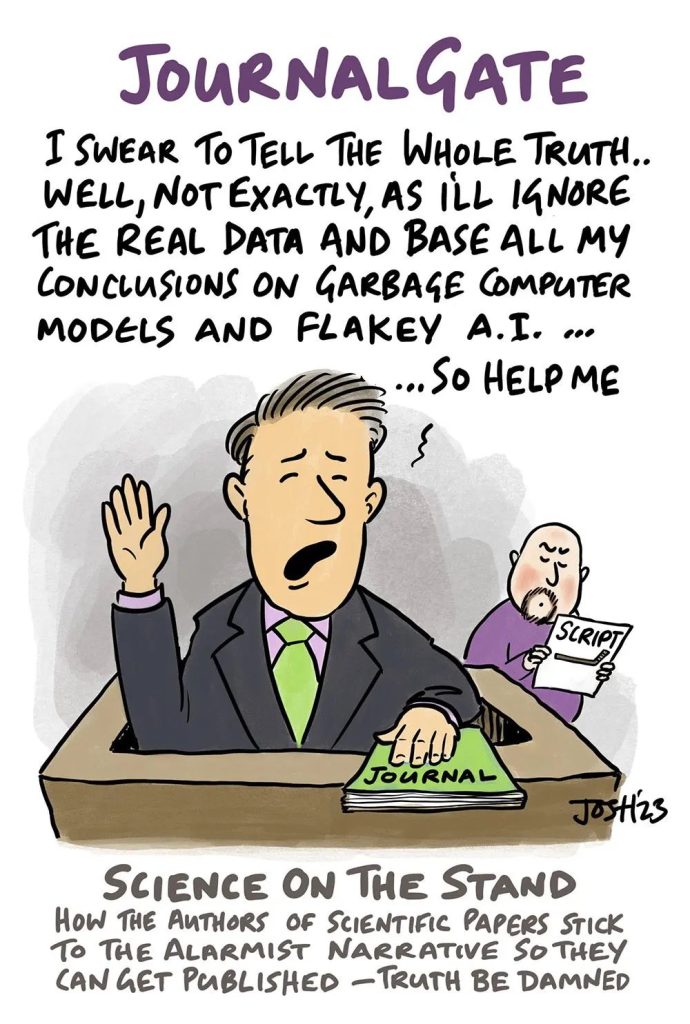
via Cartoons by Josh
